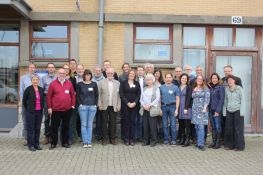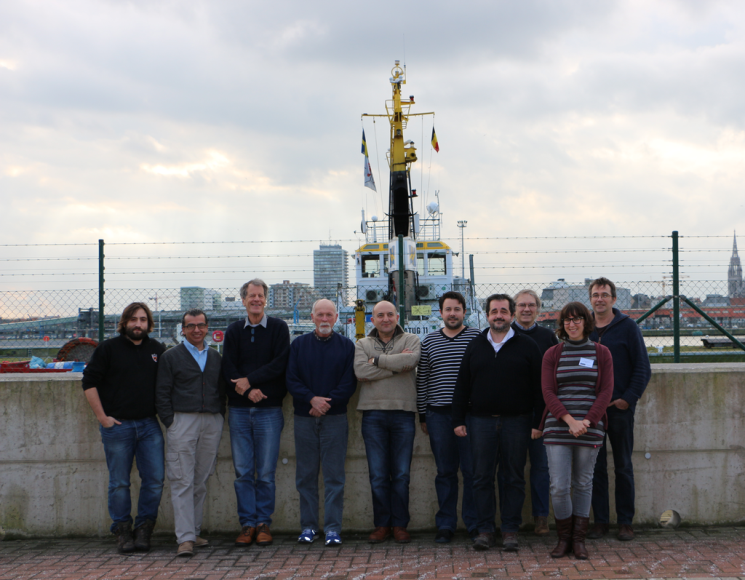LifeWatch support in 2015-2016 made it possible to make WoRMS more complete
In 2015-2016, LifeWatch funded several activities directly leading to the improvement and further completion of the World Register of Marine Species (WoRMS). LifeWatch has invested in data grants, meetings and workshops, leading to the addition of thousands of new names to WoRMS, a revision of (tens of) thousands already available names, and the development of new portals and tools, helping the user and editor community in accessing and utilizing WoRMS.

LifeWatch is the E-Science European Infrastructure for Biodiversity and Ecosystem Research. It is a distributed virtual laboratory which is being used for different aspects of biodiversity research.
The Taxonomic Backbone of LifeWatch aims at bringing together taxonomic and species-related data and at filling the gaps in our knowledge. In addition, it gives support to taxonomic experts by providing them logistic and financial support for meetings and workshops related to expanding the content and enhancing the quality of taxonomic databases. As WoRMS is a major player in this Taxonomic Backbone, funds were made available during 2015 to support the further development of WoRMS and its related databases, both on the content and technical level.
Early 2015, a call for applications for small, targeted data grants to fill the taxonomic gaps was launched. Through the LifeWatch project, a dedicated budget was made available to allow editors to apply for a such a small grant, with a focus on completing an verifying the taxonomic information within their group of expertise. For groups that were already nearing completion, a grant could be requested to document e.g. the original descriptions, add information on type localities or focus on the addition of synonym names.
In total, 17 LifeWatch grants were assigned covering a wide taxonomic variety: Amphipoda (4), Asteroidea (1), Hippoidea-Epicaridea-Rhizocephala (1), Isopoda (2), Mollusca (3), Nematoda (3), Polychaeta (1), Porifera (1) and Tardigrada (1). Through these grants, more than 3400 new names could be added to WoRMS, many thousands of names already available in WoRMS were taxonomically revised, and several original descriptions references (with PDF if available) were added. In addition, a multitude of missing authorities, type material information, type localities, distributions, notes, and images was added as well. Most grants were finalized by the end of June; with a few grant projects continuing until the end of summer. An overview of these data grants – with their goals and a final report – is available through the WoRMS website.
In February 2016, LifeWatch funds made it possible for Ascidiacea experts from all over the world, and a special guest: the world-renowned ascidian taxonomist Françoise Monniot, to meet for the very first time and to discuss future plans for the Ascidiacea World Database. During this Ascidiacea World Database Editor Workshop, the editorial team tackled knowledge gaps and issues identified prior to the workshop. Following a hands-on training session about the online editing interface organized by the WoRMS Data Management Team (DMT), many Ascidiacea species records and distribution were added, and several taxonomic issues were resolved during the workshop.

Ascidiacea Workshop (February 2016)
Also through the financial support of LifeWatch, the creation of a World Register of Cave Species (WoRCS) has been initiated. WoRCS aims to create a comprehensive taxonomic and ecological database of species known from marine and anchialine cave environments worldwide. In February 2016, eight experts on marine and anchialine cave faunas gathered at VLIZ. During this WoRCShop, the WoRCS editorial team had the opportunity to make editorial agreements and discuss future plans and options in person. The WoRCShop can definitely be labeled as highly successful: during the hands-on session, no less than 900 species known to occur in cave environments have been added to the database.

WoRCShop (February 2016)
In April 2016, a third LifeWatch-WoRMS workshop brought together – for the first time since the launch of the database in 2013 – the majority of the Amphipoda editors (22 out of 32). During this 2-day World Amphipoda Database Editor Workshop, the focus was largely on hands-on training organized by the WoRMS Data Management Team (DMT), providing the editors with the tools and experience to actively complete the World Amphipoda Database. Several available tools and functionalities were demonstrated, helping editors to more easily edit using the online interface. All editors entered new taxa and information and edited existing data, thereby improving the content and quality of the Amphipoda Database. In addition, the group took time to discuss editing guidelines and ongoing Amphipoda initiatives, including four ongoing LifeWatch Data projects, covering all environments.

Amphipoda Workshop (April 2016)
And finally, the World Ostracoda Database Editor Workshop took place in May at VLIZ, during which the future plans for the World Ostracoda Database (WOD) were discussed. The goals of this workshop were to: (1) unite Ostracoda WoRMS editors towards WoRMS’s goals; (2) set clear, specific goals for each editor in the future, in order to keep WoRMS complete for new Ostracoda taxa being described, new classifications, new combinations and upload the few taxa already been described but still missing; (3) decide on which higher level taxonomy to use for Ostracoda; (4) assign Incertae sedis taxa to higher levels; (5) get training in the use of the online interface and the available tools; (6) decide on how to document the authorship of taxa; (7) re-write the introduction page of WOD; (8) integrate the “fossil Myodocope Database” into WOD; (9) integrate additional Halocyprida data into WOD; and (10) integrate hundreds of good quality SEM and optic microscope photos into WOD.
All of the above mentioned work (both grants and workshops) was supported by staff members provided by the Flanders Marine Institute (VLIZ) as part of the Flemish contribution to LifeWatch, and is funded by FWO Vlaanderen.
The Taxonomic Backbone of LifeWatch aims at bringing together taxonomic and species-related data and at filling the gaps in our knowledge. In addition, it gives support to taxonomic experts by providing them logistic and financial support for meetings and workshops related to expanding the content and enhancing the quality of taxonomic databases. As WoRMS is a major player in this Taxonomic Backbone, funds were made available during 2015 to support the further development of WoRMS and its related databases, both on the content and technical level.
Early 2015, a call for applications for small, targeted data grants to fill the taxonomic gaps was launched. Through the LifeWatch project, a dedicated budget was made available to allow editors to apply for a such a small grant, with a focus on completing an verifying the taxonomic information within their group of expertise. For groups that were already nearing completion, a grant could be requested to document e.g. the original descriptions, add information on type localities or focus on the addition of synonym names.
In total, 17 LifeWatch grants were assigned covering a wide taxonomic variety: Amphipoda (4), Asteroidea (1), Hippoidea-Epicaridea-Rhizocephala (1), Isopoda (2), Mollusca (3), Nematoda (3), Polychaeta (1), Porifera (1) and Tardigrada (1). Through these grants, more than 3400 new names could be added to WoRMS, many thousands of names already available in WoRMS were taxonomically revised, and several original descriptions references (with PDF if available) were added. In addition, a multitude of missing authorities, type material information, type localities, distributions, notes, and images was added as well. Most grants were finalized by the end of June; with a few grant projects continuing until the end of summer. An overview of these data grants – with their goals and a final report – is available through the WoRMS website.
In February 2016, LifeWatch funds made it possible for Ascidiacea experts from all over the world, and a special guest: the world-renowned ascidian taxonomist Françoise Monniot, to meet for the very first time and to discuss future plans for the Ascidiacea World Database. During this Ascidiacea World Database Editor Workshop, the editorial team tackled knowledge gaps and issues identified prior to the workshop. Following a hands-on training session about the online editing interface organized by the WoRMS Data Management Team (DMT), many Ascidiacea species records and distribution were added, and several taxonomic issues were resolved during the workshop.

Ascidiacea Workshop (February 2016)
Also through the financial support of LifeWatch, the creation of a World Register of Cave Species (WoRCS) has been initiated. WoRCS aims to create a comprehensive taxonomic and ecological database of species known from marine and anchialine cave environments worldwide. In February 2016, eight experts on marine and anchialine cave faunas gathered at VLIZ. During this WoRCShop, the WoRCS editorial team had the opportunity to make editorial agreements and discuss future plans and options in person. The WoRCShop can definitely be labeled as highly successful: during the hands-on session, no less than 900 species known to occur in cave environments have been added to the database.

WoRCShop (February 2016)
In April 2016, a third LifeWatch-WoRMS workshop brought together – for the first time since the launch of the database in 2013 – the majority of the Amphipoda editors (22 out of 32). During this 2-day World Amphipoda Database Editor Workshop, the focus was largely on hands-on training organized by the WoRMS Data Management Team (DMT), providing the editors with the tools and experience to actively complete the World Amphipoda Database. Several available tools and functionalities were demonstrated, helping editors to more easily edit using the online interface. All editors entered new taxa and information and edited existing data, thereby improving the content and quality of the Amphipoda Database. In addition, the group took time to discuss editing guidelines and ongoing Amphipoda initiatives, including four ongoing LifeWatch Data projects, covering all environments.

Amphipoda Workshop (April 2016)
And finally, the World Ostracoda Database Editor Workshop took place in May at VLIZ, during which the future plans for the World Ostracoda Database (WOD) were discussed. The goals of this workshop were to: (1) unite Ostracoda WoRMS editors towards WoRMS’s goals; (2) set clear, specific goals for each editor in the future, in order to keep WoRMS complete for new Ostracoda taxa being described, new classifications, new combinations and upload the few taxa already been described but still missing; (3) decide on which higher level taxonomy to use for Ostracoda; (4) assign Incertae sedis taxa to higher levels; (5) get training in the use of the online interface and the available tools; (6) decide on how to document the authorship of taxa; (7) re-write the introduction page of WOD; (8) integrate the “fossil Myodocope Database” into WOD; (9) integrate additional Halocyprida data into WOD; and (10) integrate hundreds of good quality SEM and optic microscope photos into WOD.
All of the above mentioned work (both grants and workshops) was supported by staff members provided by the Flanders Marine Institute (VLIZ) as part of the Flemish contribution to LifeWatch, and is funded by FWO Vlaanderen.



